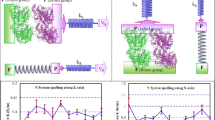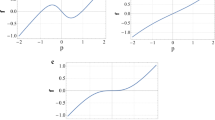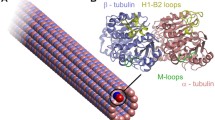Abstract
The mechanical properties of the αβ-tubulin dimer of microtubules was modeled by using the molecular dynamics (MD) simulation method. The effect on the mechanical properties of the dimer of the existence and nonexistence of an applied electric field, either constant or periodic, was studied. Since there are charged or polar groups in the dimer structure, the electric field can interact with the dimer. The elastic constant and Young’s modulus of the dimer were decreased when the dimer was exposed to a constant electric field of 0.03 V/nm. Furthermore, applying an oscillating electric field in the 1 GHz range to the dimer increased the elastic constant and Young’s modulus of the dimer. These parameters were related to dimer rigidity and, consequently, in this frequency range, the application of electric fields may affect the function of microtubules.




Similar content being viewed by others
References
Nogales E, Wolf SG, Downing KH (1998) Structure of αβ-tubulin dimer by electron crystallography. Nature 391:199–203
Nogales E, Whittaker M, Miligan RA, Downing KH (1999) High-resolution model of the microtubule. Cell 96:79–88
Lowe J, Li H, Downing KH, Nogales E (2001) Refined structure of αβ-tubulin at 3.5 Å resolution. J Mol Biol 313:1045–1057
Felgner H, Frank R, Schliwa M (1996) Flexural rigidity of microtubules measured with the use of optical tweezers. J Cell Sci 109:509–516
Pampaloni F, Lattanzi G, Jonas A, Surrey T, Frey E, Florin EL (2006) Thermal fluctuations of grafted microtubules provide evidence of a length-dependent persistence length. Proc Natl Acad Sci USA 103:10248–10253
Wagner O, Zinke J, Dancker P, Grill W, Bereiter-Hahn J (1999) Viscoelastic properties of F-actin, microtubules, F-actin/a-actinin, and F-actin/hexokinase determined in microliter volumes with a novel nondestructive method. Biophys J 76:2784–2796
Guo H, Xu C, Liu C, Qu E, Yuan M, Li Z, Cheng B, Zhang D (2006) Mechanism and dynamics of breakage of fluorescent microtubules. Biophys J 90:2093–2098
Kis A, Kasas S, Babic B, Kulik AJ, Benoit W, Briggs GAD, Schonenberger C, Catsicas S, Forro L (2002) Nanomechanics of microtubules. Phys Rev Lett 89(1–4):248101
Sept D, MacKintosh FC (2010) Microtubule elasticity: connecting All-atom simulations with continuum mechanics. Phys Rev Lett 104(1–4):018101
Wells DB, Aksimentiev A (2010) Mechanical properties of a complete microtubule revealed through molecular dynamics simulation. Biophys J 99:629–637
Soncini M, Enemark S, Aprodu I, Deriu M (2006) characterization of microtubule and motor proteins via molecular dynamics simulotion. CILEA 121–134
Wu Z, Nogales E, Xing J (2012) Comparative studies of microtubule mechanics with two competing models suggest functional roles of alternative tubulin lateral interactions. Biophys J 102:2687–2689
Feng S, Liang H (2012) A coarse grain model of microtubules. Theo Appl Mech Lett 2(1–4):014006
Lohrasebi A, Mohamadi S, Fadaie S, Rafii-Tabar H (2012) Modelling the influence of thermal effects induced by radio frequency electric field on the dynamics of the ATPase nanobiomolecular motors. Physica Med 28:221–229
Lin YS, Lin JH, Chang CC (2010) Molecular dynamics simulations of the rotary motor F0 under external electric fields across the membrane. Biophys J 98:1009–1017
Xiang BY, Ngadi MO, Simpson BK, Simpson MV (2011) Pulsed electric field induced structural modification of soy protein isolate as studied by fluorescence spectroscopy. J Food Proc Preserv 35(5):563–570
Singh A, Orsat V, Raghavan V (2013) Soybean hydrophobic protein response to external electric field: a molecular modeling approach. Biomolecules 3(1):168–179
Khalili-Araghi F, Tajkhorshid E, Schulten K (2006) Dynamics of K+ ion conduction through Kv1.2. Biophys J 91:72–74
Sajadi M, Lohrasebi A, Rafii-Tabar H (2013) Modeling the effect of a GHz electric field on the dynamics of K+ ions in KcsA potassium channel. Mol Sim 5:399–407
Hess B, Kutzner C, Van der Spoel D, Lindahl E (2008) GROMACS 4: algorithms for highly efficient, load-balanced, and scalable molecular simulation. J Chem Theory Comp 4:435–447
Author information
Authors and Affiliations
Corresponding author
Rights and permissions
About this article
Cite this article
Saeidi, H.R., Lohrasebi, A. & Mahnam, K. External electric field effects on the mechanical properties of the αβ-tubulin dimer of microtubules: a molecular dynamics study. J Mol Model 20, 2395 (2014). https://doi.org/10.1007/s00894-014-2395-1
Received:
Accepted:
Published:
DOI: https://doi.org/10.1007/s00894-014-2395-1




